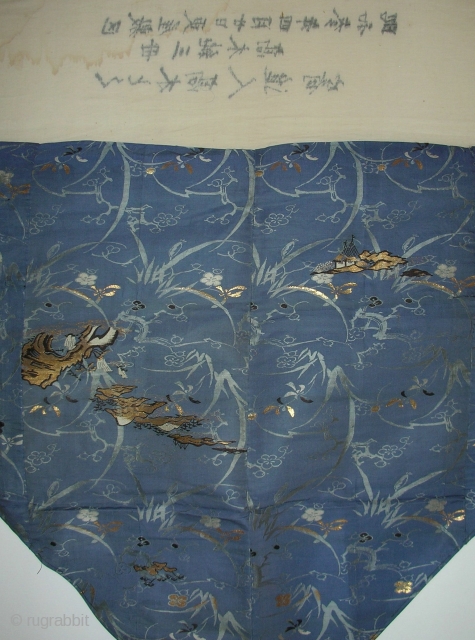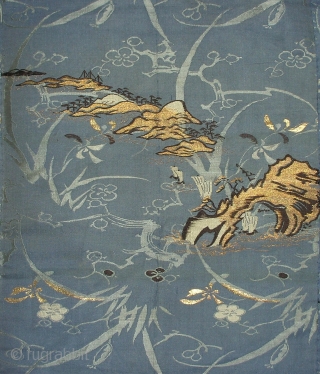Back
Silk temple cloth, Japan, early Showa (dated 1929), cm 212x113. This is an ‘uchishiki’, a cloth of rich silk used to decorate altars in Buddhist temples. The origin of the uchishiki can be traced back to the lifetime of Shakyamuni Buddha. During the Buddha's time a custom was established of spreading out fine pieces of cloth for the Buddha to sit on when preaching to his disciples and others assembled to hear him. The cloth would be spread out and the disciples would bow in reverence to the Buddha with their foreheads touching the cloth at his feet. It later came to decorate the altar tables of temples on special occasions of hearing the Buddha's teaching. The cloth we are offering here has a most typical shape, that is a triangular one where the place left with no brocade silk refers to the altar top that was then covered with a different fabric. It has been obtained by patching an antique (possibly Meiji) fabric obtained by de-constructing a ‘maru obi’ (those very expensive obis, fully patterned, made of finest brocade and used on formal occasions) and offered during Showa 3 (1929) to the temple as acknowledgeable from hand-written kanji characters on the lining. The brocade itself shows - upon a light blue silk background where delicate scrolling of plants and flowers are represented ton-sur-ton – golden threads embroideries of exotic landscapes and country houses, all drawn in a much Japanese style. The large dimension on this cloth may suggest it was used on a main altar, and the very good overall condition that it was used only on specific occasions. Whatever the case, this is a rather nice example of temple cloths. Delicate and feminine in all respects.
price:
SOLD
- Home
- Antique Rugs by Region
- Category
- Profiles
- Post Items Free
- Albums
- Benaki Museum of Islamic Art
- Budapest: Ottoman Carpets
- Gulbenkian Museum
- Islamic Carpets. Brooklyn
- Islamic Textiles. Brooklyn
- Konya Museum: Rugs
- MKG, Hamburg
- MMA: Caucasian Carpets
- MMA: Mamluk Carpets
- MMA: Mughal Indian Carpets
- MMA: Ottoman Carpets
- MMA: Safavid Persian Carpets
- MMA: Turkmen Rugs
- McCoy Jones Kilims
- Ottoman textiles. Met
- Philadelphia Museum
- Rugs and Carpets: Berlin
- Seljuqs at the Met
- TIEM, Istanbul: Carpets
- V&A: Classical Carpets
- Vakiflar Carpets: Istanbul
- Baluch Rugs: Indianapolis
- Gallery Exhibitions
- Jaf an Exhibition
- Alberto Levi Gallery
- Andean Textile
- Christie's London: 2016
- Francesca Galloway
- HALI at 40
- ICOC Washington, DC 2018
- Jajims of the Shahsavan
- London Islamic Week April, 2018
- Mongolian Felts
- Navajo Rugs: JB Moore
- Persian Piled Weavings
- SF Tribal & Textile Art Show 2020
- SF Tribal 2019
- Sotheby's: C. Alexander
- Turkish Prayer Rugs
- Turkmen Main Carpets ICOC 2007











